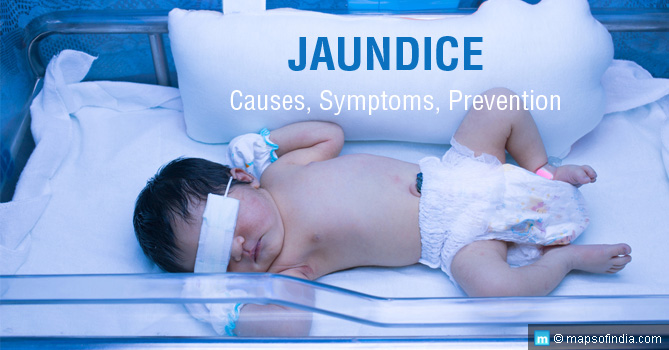Jaundice is a term that describes a condition in which the patient’s skin and sclerae develop a yellowish tinge and the blood records high quantities of Bilirubin. It is not a disease in itself, but a symptom that points to a disease or a condition that needs medical attention.
Bilirubin is a yellow coloured substance that is produced naturally by the body due to the breaking down of aged red blood cells in a 120-day cycle. Bilirubin combines with bile, a digestive fluid produced by the liver and stored in the gall bladder. This helps in absorption of food and the excretion of waste. When for some reason the Bilirubin is unable to combine with the Bile or when red blood cells break down sooner than normal, the Bilirubin levels in the blood start to rise. It may also leak into other organs lending them a tell-tale yellow tinge.
Jaundice may thus be caused by a number of diseases. Some diseases such as malaria, sickle cell anaemia, and thalassaemia increase the production of Bilirubin while others such as hepatitis, alcoholic liver disease, glandular fever, liver cancer, or even consumption of excess alcohol interrupt the liver’s ability to process the Bilirubin. Yet other conditions such as gallstones and pancreatitis interfere with the removal of Bilirubin from the body.
Symptoms of Jaundice
While Jaundice itself may be quite difficult to manage and treat, the symptoms of this disease among the easiest to identify –
- With an increase of the Bilirubin levels in the blood, the skin, the nails, and the whites (sclerae) of the eye start to take on a yellow tinge.
- Like any affliction of the liver, Jaundice too causes Pruritis or a pronounced, often uncomfortable, itch.
- Often flu-like symptoms develop and the patient experiences fever with/without chills.
- Nausea, aversion to food, and lack of appetite.
- Abdominal pains, sometimes manifesting as cramps.
- Weight loss
- Dark/yellow urine
- Constant fatigue
Reaching a Diagnosis
A doctor or medical practitioner may suspect Jaundice upon physical examination of the patient (by observing yellowness of eyes and skin). To confirm the diagnosis and to determine the severity, the doctor may administer blood tests such as –
- Bilirubin test
- Full Blood Count (FBC) or Complete Blood Count (CBC)
- Hepatitis A, B, and C tests
At times, if a doctor suspects that the jaundice may accompany further complicated conditions such as cirrhosis of the liver or cancer, the doctor may ask for a Magnetic Resonance Imaging (MRI) or an ultrasound of the abdomen or a CAT scan or a liver biopsy.
Treatment Options
In adults, Jaundice or Hyperbilirubinemia itself is not treated. The underlying cause that caused the Bilirubin build-up is treated.
In case the Jaundice is caused by an underlying condition such as malaria, the patient’s underlying disease is treated and symptoms such as itching are managed. In case of genetic disorders such as sickle cell anemia, blood transfusion may be required and in case the bile duct is blocked, a surgery may be required. In case the Jaundice is caused by a severely damaged liver, doctor may suggest a transplant.
In most cases of hepatitis infections, the jaundice clears out on its own after a period of time. Diet restrictions and adequate rest aid the recovery process.
Jaundice and Hepatitis
It is often said that Jaundice leads to Hepatitis. This may not be a very accurate statement; however, it is important to remember that Jaundice (in adults) is a symptom while Hepatitis B is a disease of the liver caused by a virus. Jaundice or hyperbilirubinemia may not always be caused by Hepatitis. Other liver diseases and genetic causes may trigger the liver’s inability to utilize the Bilirubin in the blood. Hepatitis or inflammation of the liver is usually caused by any of five different types of viruses (called Hepatitis A, B, C, D, or E). Viral Hepatitis is highly infectious as well.
Neonatal Jaundice
Neonatal jaundice or jaundice in newborns is a very common occurrence. While in the womb, the excretion of bilirubin is done by the placenta and as soon as the baby is born, its liver must start to perform this function. A failure to adapt to this quickly sometimes causes Jaundice in the baby for a few days. This usually gets better as the liver grows stronger. Breastfed babies sometimes develop Jaundice after the first week; a failure to breastfeed may also cause Jaundice in many children. Though the condition needs medical attention, the condition clears out in most cases.
Incidence in India
Despite poor record keeping in most states of the country, it is clearly evident that the incidence of Jaundice has shown a steady and alarming increase. According to a news report, death toll due to Jaundice has doubled over the past 2 decades. According to a 2014 report, there are over 40 million Hepatitis B patients living in the country. This number is second only to China. Alarmingly, most Hepatitis B or C patients are not even aware of their infection and thus are at a great risk of developing liver cirrhosis or cancer. They also act as carriers of Hepatitis infection.
Vaccination in India
In compliance with World Health Organization directives, the government of India has been supporting programmes for administration of Hepatitis A and Hepatitis B vaccines across the country. While the administration of the Hepatitis B vaccine is done only for infants, the Hepatitis A vaccine is administered both for children and adults.
Vaccine Schedule –
- Hepatitis A Vaccine
- Dose 1 – Between 12 and 23 months of age
- Dose 2 – 6 to 18 months after first dose
- Addition dose – For older kids and adults at risk.
Hepatitis B Vaccine
- Dose 1 – Within 24 hours of birth
- Dose 2 – 6 weeks after birth
- Dose 3 – 10 weeks after birth
- Dose 4 – 14 weeks after birth
- Adolescents may be administered the vaccine till the age of 18 if they have not received it at infancy.
For prevention of Hepatitis infections it is also important to eat healthy food, drink clean water, remain in hygienic surroundings, exercise regularly, and avoid consumption of alcohol.
Read More:
Dengue and Chikungunya: Causes, Symptoms, Prevention, Treatment
Communicable Diseases In India: Symptoms, Causes, prevention and Treatments
Health & Fitness Gadgets
Hepatitis B in India: Guidelines for Prevention, Symptoms, Causes, Risks & Treatment
Tobacco – The Leading Cause of Illnesses
How to Stay Healthy During Monsoons? Do’s and Don’ts
Non-Communicable Diseases – Take Care, Before It’s Late
Swine Flu: What You Need to Know and Do
Prevention of Heart Attack and Other Related Heart Diseases
Leprosy – Causes, preventions and eradication programme
Prevalence of Diabetes in India
The Fever : Vaccination Still An Elusive Proposal
Sharp rise in non polio Acute Flaccid Paralysis after polio-free status
Organ Donation in India





